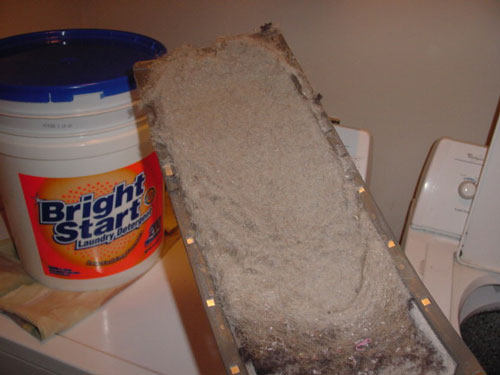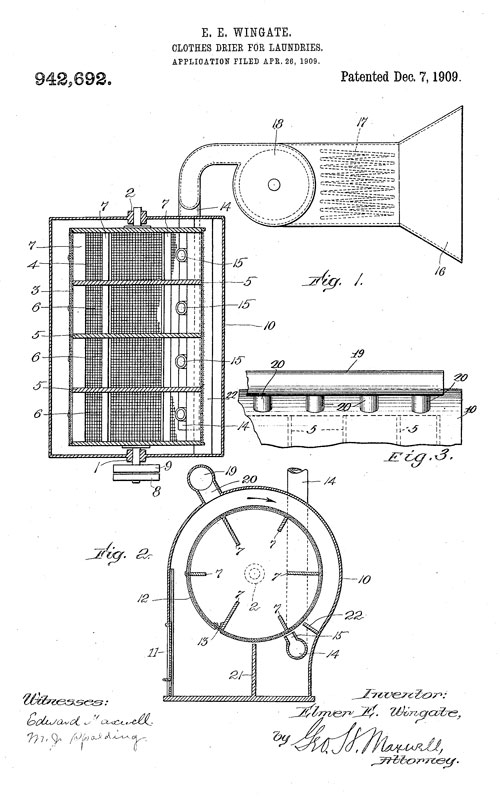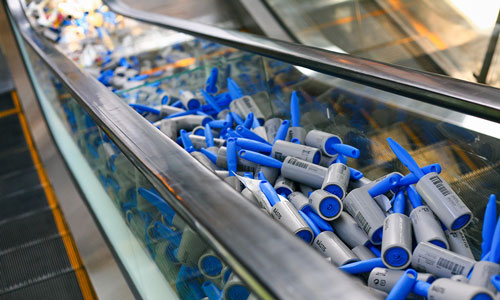Lint, Filtered
Like lint? This article is for you. Learn why dryers produce lint, and how the lint roller came into existence. It's the lintiest article you'll ever read.
Hey all, Ernie here with a refreshed piece on dryer lint, a substance that springs eternal. Cheers!
Today’s Tedium is brought to you by Chargebee. More from them in a second.
1793
The year that Eli Whitney first filed for a patent for the cotton gin, the iconic device that set the stage for both the industrial revolution and, later down the line (through the growth of slavery the device indirectly encouraged), the Civil War. The machine was able to remove the seeds from the cotton, or as it was commonly referred to, the lint. (Lint, of course, is defined as a material produced from cotton, often by scraping.) This allowed for higher amounts of production than could previously be done by hand. Whitney, however, got little of that “lint” himself—with the U.S. patent system still brand new and his invention relatively easy to recreate, he saw little of the wealth that his device generated.

This is what happens when you don’t empty a lint filter for a really long time. (Gregor Smith/Flickr)
The unsung industrial roots of the lint trap
The home-based clothes dryer is a fascinating object, because it’s one of the few home-based machines that produces what could be considered an unwanted byproduct.
It may not be called a “drying machine” by most people in the way that people might say “washing machine,” but it is very much a machine, and unlike, say, an oven (which expels heat into a home temporarily) or a dishwasher (in which any waste goes down the drain, essentially), the dryer essentially expels waste materials that would have once been located within your clothing.
Why did we choose this particular method to try our clothes—a method that includes an obvious physical byproduct?
To put it simply, it was the best way that showed itself over a period of more than 100 years.
The dryer as we know it carries roots from a few evolutionary innovations:
The “ventilator,” a hand-crank-driven device created by a Frenchman named M. Pochon at the turn of the 19th century. This device, per pop-historian Charles Panati, introduced the tumbling mechanism to drying, but did so over an open flame, which kind of gave clothes a burny smell. Understandably, this approach didn’t catch on.
The “hot closet,” a small room, attached to a laundry area, that’s designed to use steam to warm up and then dry out wet clothing, was put to use in the latter half of the 19th century in some homes, as an alternative to the clothesline.
The indoor clothing line: Early black inventor George T. Samson didn’t rely on tumble drying for his invention, essentially a spot to hang clothes above a stove, but it was notable for being designed in such a way it could be used indoors. It was a major improvement over Pochon’s basic idea.
But perhaps the biggest driving factor of the dryer was what was happening on the factory floors of the industrial revolution.
While the clothes dryer as we know it entered the American home in the 1940s, it was predated by many industrial variations that have a lot in common with what actually ended up in our laundry rooms. In a lot of ways, these devices worked out many of the issues with dryers before they came into our homes.
Turn-of-the-century firms were experimenting with large rotary dryers at scale.
And that means they were among the first to take on the lint problem, with the tumbling, rotary devices creating lots of lint as a byproduct of all the rolling around.

Elmer E. Wingate’s take on a rotary clothes drier. (Google Patents)
“My invention is a rotary clothes drier having three principal objects, viz. the drying of a washing with extreme rapidity, effecting said drying without unduly mussing or injuring the clothes, and effectually removing all the lint therefrom during the process of drying,” one 1909 patent, granted to Elmer E. Wingate, states.
A 1913 patent from Richard Roost of the American Laundry Machine Company highlights how his company’s machine, an early tumble-dryer, uses the exhaust to improve the evaporation process and remove lint.
“Of course, a great advantage is found in the reduction of pressure by using the exhaust fan instead of the blower inasmuch as the one tends to increase the pressure in the cylinder or tumbler, thereby retarding vaporization, while the other, to the extend that it greatly reduces pressure, greatly aids the evaporation. It also carries the lint from the machine through the exhaust,” Roost explains.
A 1925 patent from Frank M. Watkins, his invention targeted at “laundries where large amounts of clothes are washed,” makes reference to lint traps.
These patents added on one another, proving fundamental to the eventual dry cleaning and laundromat industries that cropped up during the 20th century.
Eventually, a fellow named J. Ross Moore tried selling the concept of the electric clothes dryer for the home. He had a lot of doors slammed into his face in the process of making his pitch. But with the support of the Hamilton Manufacturing Company, he made it a reality in the late 1930s.
And that’s how these massive lint-collecting machines were introduced to our homes. (Oh yeah, they dry clothes.)
Sponsored By Chargebee
Running a startup? Here are two founders you should meet:
1933. South Dakota. Dorothy, a pharmacist named Ted Hustead’s wife has a promising idea, one that when fully realized will put their small drug store on the path towards 2 million annual visitors. An idea that allowed their destinies to converge with those of “road weary” travelers visiting Mt. Rushmore: giving away free ice water. That store, of course, was (and is) Wall Drug.
That same dynamic of giving away free value in order to drive growth, is at the heart of some of the biggest tech brands. Spotify. MailChimp. Trello. Wistia. All consider the freemium model a key reason for their incredible successes.
But, what, exactly, makes it tick? And, as a startup founder/operator, how can you wield it for growth? Hear from those who’ve mastered it at companies such as Skype, Dribbble, and Atlassian on Wielding Freemium!
Register (for free, of course) for Wielding Freemium, the first-ever virtual event, dedicated to understanding this growth model.
92%
The percentage of laundry-related fires that are directly the result of dryers, according to the National Fire Protection Association. Often, this is the result of dryer lint traps that haven’t been properly cleaned. (Combination washer/dryers are responsible for 5 percent, but something tells me the washer part of those machines usually aren’t at fault.) Annually, laundry-related fires—more than 15,000 per year between 2010 and 2014—caused, on average, $238 million in direct property damage, 440 injuries, and 13 deaths each year. Scary, huh? Clean your lint trap.

Lint rollers at an Ikea in Beijing. (Gordon Lew/Flickr)
Sometimes, the lint doesn’t come off in the dryer. Enter the lint roller.
The story of Nicholas McKay was a tale that was bound to happen to anyone, but it happened to him. And anyone who’s ever had dust bunnies on an old suit and no chance of getting to the dry cleaners knows where this story is going.
Here’s the gist of what happened: McKay and his wife, Helen, had to go chaperone a school dance. However, McKay had forgotten to take his sport coat to the dry cleaners, so it was covered in lint.
McKay, fortunately, was a guy who knew a thing or two about engineering, so he was able to improvise a quick solution—using a discarded toilet paper holder, a piece of wire, and some masking tape. That solution became the modern-day lint roller, that plastic-and-adhesive device that picks up the extra gunk on your clothes.
He went to work on that invention the next day, of course, filing for a patent in 1957 and receiving said patent in 1963.
Now, to be fair, there is some prior art for the device that predates McKay by a few years—advertisements for the the Pixall, a paint-roller style device, showed up in the Los Angeles Times as early as 1948, and the U.S. Patent Office granted a patent for a lint remover to a variety of inventors, including Homer T. Clark and Carl J. Paterson, as early as 1944. And there were designs that were similar to McKay’s design, but not exactly the same.
But McKay’s design is the one we ended up with, likely due to a mix of smart marketing and better design. With the support of his wife Helen, McKay formed the company Helmac, which quickly took the lint roller national and helped ensure its long-term success.
Over the years, McKay’s company saw a lot of success, even showing up in films. In a 1991 Associated Press article, the roller was even cited for its small role in a William Hurt film.
(Of course, as we all know, the best product placement for the lint roller didn’t come until 2014, when Drake decided it would be a good idea to ensure his pants were unlinted during a playoff game involving his Toronto Raptors.)
The lint roller is a great invention, one that probably doesn’t need significant updates, but perhaps the most interesting wrinkle in the lint roller’s story actually involves its primary corporate parent. As Forbes reported in 2003, the firm found itself attempting to broaden its mainstream appeal, so it went to a well-known brand consultant in 1998 for some help in building out its new product lines.
The brand consultant told them that the company’s big problem was their name, Helmac. This was an awkward conversation for the company, as the firm was named after Nicholas McKay’s wife, Helen, who helped the company for 28 years but had died by this point. But Landor Associates found that people associated the name with mayonnaise, helmets, and …
uh, hell.
And that’s why you won’t find a Helmac lint roller anywhere. Landor suggested Evercare instead—and that’s what they went with.
(Nicholas McKay himself passed in 2014 at the age of 93, which means he lived a long enough life that the Drake moment happened on his watch. Whew.)
“Well, I failed to bring Roger to Flint. As we neared the end of the twentieth century, the rich were richer, the poor, poorer. And people everywhere now had a lot less lint, thanks to the lint rollers made in my hometown. It was truly the dawn of a new era.”
— Michael Moore, in the closing lines of his film Roger & Me, discussing the other notable invention that came out of his hometown of Flint, Michigan. Like General Motors, Helmac ultimately moved away. The reason was somewhat of a depressing sign of the times: Despite growing significantly in the ’90s, the company needed to expand its headquarters. The state, however, couldn’t decide on tax incentives, so the company moved the whole production to Georgia in 1999. So no, lint rollers didn’t make it to the 21st century in Flint.
One of the byproducts I took away from doing this piece—the lint, so to say—is the fact that we put a lot of weight as a society around the single inventor—even if, in some contexts, they get too much credit, or not enough.
I look at Eli Whitney and wonder how timing hurt his role as an inventor. Had he come up with the cotton gin just 15 years later, when the U.S. had its stuff together a little bit more on the patent front, Whitney might have been able to protect his rights a little bit better—and he might have also seen the financial success that came with his big idea.
In the case of the dryer, there’s a very strong lean on J. Ross Moore as the inventor, despite the fact that there was a lot of prior art happening in the industrial world around the tumble dryer. George T. Samson, likewise, gets a lot of plaudits for his work, as he’s a notable example of a 19th-century black inventor, though it’s worth noting that his efforts weren’t a direct influence on the tumble-drying we actually got.
Meanwhile, I look at someone like Nicholas McKay, who clearly created something of significant value—a market for the lint roller. Even though he wasn’t first, technically, he still gets the lion’s share of the credit in the history books. It’s how it happens sometimes.
The fact is, while single inventor stories are sexy and make for great story arcs, the truth is that the inventions we actually get pile up on one another, collecting in a single space over a period of time.
You know, like lint.
--
Find this one an interesting read? Share it with a pal! And thanks again to Chargebee for sponsoring.
:format(jpeg)/2017/07/tedium071117--1-.gif)
/2017/07/tedium071117--1-.gif)


/uploads/ernie_crop.jpg)